- Region
- Águilas
- Alhama de Murcia
- Jumilla
- Lorca
- Los Alcázares
- Mazarrón
- San Javier
-
ALL AREAS & TOWNS
- AREAS
- SOUTH WEST
- MAR MENOR
- MURCIA CITY & CENTRAL
- NORTH & NORTH WEST
- TOWNS
- Abanilla
- Abarán
- Aguilas
- Alamillo
- Alcantarilla
- Aledo
- Alhama de Murcia
- Archena
- Balsicas
- Blanca
- Bolnuevo
- Bullas
- Cañadas del Romero
- Cabo de Palos
- Calasparra
- Camping Bolnuevo
- Campo De Ricote
- Camposol
- Canada De La Lena
- Caravaca de la Cruz
- Cartagena
- Cehegin
- Ceuti
- Cieza
- Condado de Alhama
- Corvera
- Costa Cálida
- Cuevas De Almanzora
- Cuevas de Reyllo
- El Carmoli
- El Mojon
- El Molino (Puerto Lumbreras)
- El Pareton / Cantareros
- El Raso
- El Valle Golf Resort
- Fortuna
- Fuente Alamo
- Hacienda del Alamo Golf Resort
- Hacienda Riquelme Golf Resort
- Isla Plana
- Islas Menores & Mar de Cristal
- Jumilla
- La Azohia
- La Charca
- La Manga Club
- La Manga del Mar Menor
- La Pinilla
- La Puebla
- La Torre
- La Torre Golf Resort
- La Unión
- Las Palas
- Las Ramblas
- Las Ramblas Golf
- Las Torres de Cotillas
- Leiva
- Librilla
- Lo Pagan
- Lo Santiago
- Lorca
- Lorquí
- Los Alcázares
- Los Balcones
- Los Belones
- Los Canovas
- Los Nietos
- Los Perez (Tallante)
- Los Urrutias
- Los Ventorrillos
- Mar De Cristal
- Mar Menor
- Mar Menor Golf Resort
- Mazarrón
- Mazarrón Country Club
- Molina de Segura
- Moratalla
- Mula
- Murcia City
- Murcia Property
- Pareton
- Peraleja Golf Resort
- Perin
- Pilar de la Horadada
- Pinar de Campoverde
- Pinoso
- Playa Honda
- Playa Honda / Playa Paraíso
- Pliego
- Portmán
- Pozo Estrecho
- Puerto de Mazarrón
- Puerto Lumbreras
- Puntas De Calnegre
- Region of Murcia
- Ricote
- Roda Golf Resort
- Roldan
- Roldan and Lo Ferro
- San Javier
- San Pedro del Pinatar
- Santiago de la Ribera
- Sierra Espuña
- Sucina
- Tallante
- Terrazas de la Torre Golf Resort
- Torre Pacheco
- Totana
- What's On Weekly Bulletin
- Yecla


- EDITIONS:
 Spanish News Today
Spanish News Today
 Alicante Today
Alicante Today
 Andalucia Today
Andalucia Today
The Fuerte de Navidad, a well-preserved 18th century military fortress in the bay of Cartagena
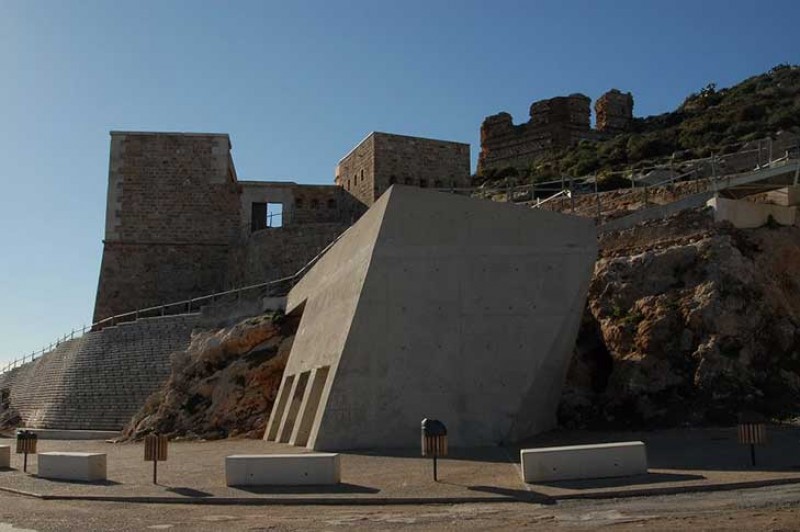
A small museum, great views and an insight into the military history of the port of Cartagena
For millennia Cartagena has been a safe haven for sailors on account of its natural protected harbour, where the bay is surrounded by rocky outcrops which facilitate effective protection and defence, and this strategic defensive advantage has made it a much coveted port for thousands of years. Partly for this reason the area was conquered or colonized by a series of civilizations including the Carthaginians, the Romans, the Visigoths, the Byzantines and the Moors before what is now the Region of Murcia was reconquered by the Christian forces of northern Spain in the 13th century. All of these cultures traded from the port to some extent, some more than others, and exploited the rich minerals mined from the nearby mountains as well as a vast array of other goods. (Click here for articles related to the history of Cartagena.)

Over the course of the centuries many different fortifications have protected Cartagena, well before the spread of the use of gunpowder in the 16th century changed the face of defensive tactics. Once cannon were introduced into military strategy a new kind of defensive network was needed to protect Cartagena from attacks from the sea, and when the port became a permanent base for the Spanish fleet this prompted the creation of a series of artillery batteries of which the Fuerte de Navidad, on the western side of the entrance to the bay, was one.
In the late 17th century, during the reign of Carlos II, Cartagena became the winter base of Spain’s galley ship squadron, and in consequence four defensive fortifications were built at the mouth of the port to ensure the protection of the ships: these were the Podadera and Fuerte de Navidad on the western side and Trincabotijas and Santa Ana to the east. Due to limited firing ranges cannon emplacements were needed on both sides of the bay to ensure that all of the water was covered, and this crossfire protection was to last for centuries while undergoing modifications.
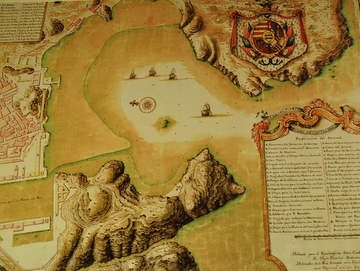
After the War of the Spanish Succession in the early 18th century, when the Fuerte de Navidad was first captured by the English on behalf of the pretender to the Spanish throne, the Archduke Charles of Austria, and then re-captured for Felipe V by the Duke of Berwick, Cartagena became the headquarters of the Maritime Department of the Mediterranean. As a result, the Naval Arsenal of Cartagena was built and this increased the need to fortify the port, so in 1740 a full scale defensive system was constructed using casemates, a system of positioning artillery pieces in chambers which protected them from fire. The Fuerte de Navidad was re-built in this way and is still an excellent example of this style of fortification: the small museum inside shows others, together with detailed information about their construction and the firing of a cannon, all translated into English.
Under Carlos III many other great military projects were also undertaken in Cartagena, including the Military Hospital, the last defensive walls to be built around the city and the castles of Las Galeras, Atalayas, San Julián and Los Moros.
But during the 19th century technological advances again brought about a complete re-modelling of the Cartagena defence system and the 1860 "O'Donnell" defence plan brought the construction of another series of batteries, not only at the entrance to the bay but also along the surrounding coastline, with complicated crossfire patterns and the elaborate positioning of the fortifications ensuring the coastline was fully protected. Many of the batteries along the coastline of Cartagena date from this period.
Again, though, within just a few years of their construction they were obsolete and many of the batteries were re-modelled yet again, although in the case of the Fuerte de Navidad the fortress was left as it was and more modern artillery was located in other batteries.
The fort was last used in 1941, two years after the end of the Spanish Civil War, although by this time it had been taken out of active service and was used only as Cartagena’s gun saluting battery, and in the second half of the 20th century it suffered the same fate as many of the other military installations in the area, being left empty and in a state of decline.
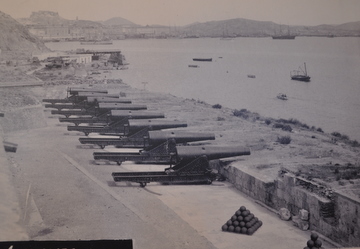
Its resurrection as a tourist attraction has been a complicated process as it is still technically owned by the military, but its refurbishment was undertaken jointly by the Town Hall of Cartagena and the regional government of Murcia between 2004 and 2007 and it now provides an interesting and enjoyable addition to any tourist itinerary.
Accessed either by car or by the tourist boat which leaves from the seafront in the city centre, it is an interesting location for all ages and is of particular interest for those with any interest in military history. The excellent visuals are in English and Spanish and there are models to entertain the youngsters, as well as a coffee shop and fantastic views across the bay of Cartagena to delight even those with no interest in the military intricacies of the fort!
The exhibits and information panels provide a real sense of what life was like for the men who lived here: for example, the display boards in the kitchen area contain information about the diet of 19th century soldiers, revealing the paucity that made a trip back to their home villages a much anticipated event due to the possibility that they may bring back something as luxurious as a bit of dried sausage to supplement a wearisome diet of basic staples.
There is also an element of fun, with soldier cut-outs on the battlements offering one of the best photo opportunities in Cartagena, and the newly remodelled lighthouse and dock areas are an enjoyable place to stroll and photograph.
Inside the fortress
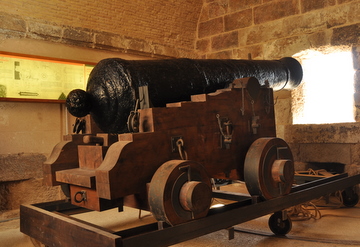
The building can be divided into two halves, with the left-hand side as visitors walk in devoted to artillery pieces and gunpowder – this is the area from which cannon were fired out into the bay – and the right-hand side to the garrison, with its kitchen and sleeping area. There is also a small souvenir shop alongside vending machines and a lift leading up to the first floor.
On the left the fort consists of eight casemates connected by a corridor running along behind them, while above is an esplanade on which another eight cannon could be mounted. The gunpowder store is in the centre of the eight casemates and has no opening to the outside.
In the centre of the ceiling of each casemate is a hook which was used as part of a winching system to raise and lower cannon, and each casemate also has niches in the walls in which gunpowder and cannonballs would have been kept.
To protect each casemate from the impact of the cannon as they were fired bomb-proof vaults were created: in other words, above each chamber earth and stones were piled up to a depth of two metres.
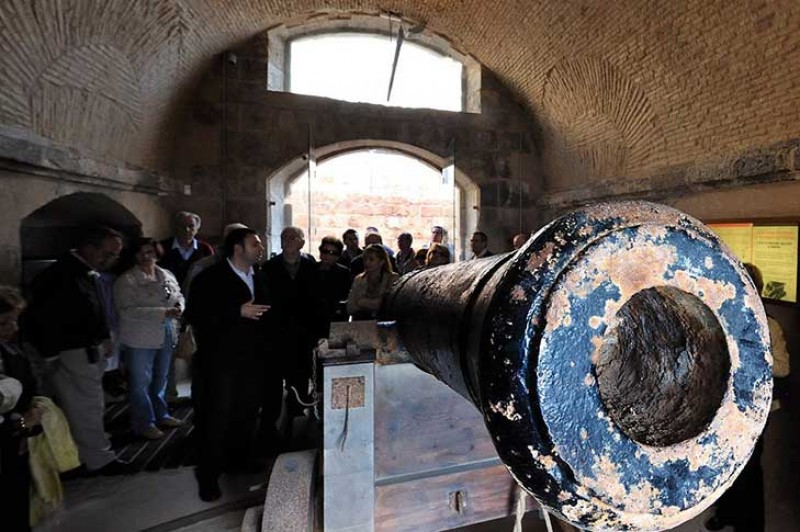
In this area panels provide information about the different fortifications which protected Cartagena and how the Fuerte de Navidad was built, while other exhibits include items which illustrate the daily life of those who manned the fort.
On the right-hand side, apart from the sleeping area and kitchen, are the latrines and a food store, all reached via the central patio and ramps and staircases. These areas also contain various audio-visuals and other displays.
The name of the fortress
The name “Fuerte de Navidad” translates literally as “Christmas Fort”, but why this fortification should be so called is not known. It may that one of the successive structures was officially inaugurated at Christmas, or it may be related in some way to the fortress of La Navidad in the Caribbean: on Christmas Eve 1492 Columbus sailed around the island of Hispaniola (now Haiti and the Dominican Republic) but one of his ships, the Santa María, drifted onto a sand bank and was stranded.
Columbus ordered that the crew stay on the island and build a fortress and settlement using the timber from their ship and named the new colony “Puerto de la Navidad” (Christmas Port).
Opening hours
High season (1st July to 15th September)
Tuesday to Saturday 11.00 to 15.00 and 16.30 to 19.30
Sundays 11.00 to 15.00
Mid season (15th March to 30th June)
Tuesday to Sunday 11.00 to 15.00
Mid season (16th September to 1st November)
Tuesday to Saturday 11.00 to 17.30
Sunday 11.00 to 15.00
Low season (2nd November to 10th December)
Tuesday to Friday 10.00 to 14.00
Saturday and Sunday 11.00 to 16.00
Closed 11th December to 14th March.
Note: groups with prior reservation will be given preference at the entrance.
Admission Charges
Admission to the fortress
Adults 3.50 euros, reduced admission 2.50 euros (under 12s, pensioners, unemployed, students, disabled, large families and groups).
Admission plus tourist boat from the port in Cartagena
Adults 8 euros, reduced rate (see above) 6 euros.
Admission is free for children aged under 3.
How to get there
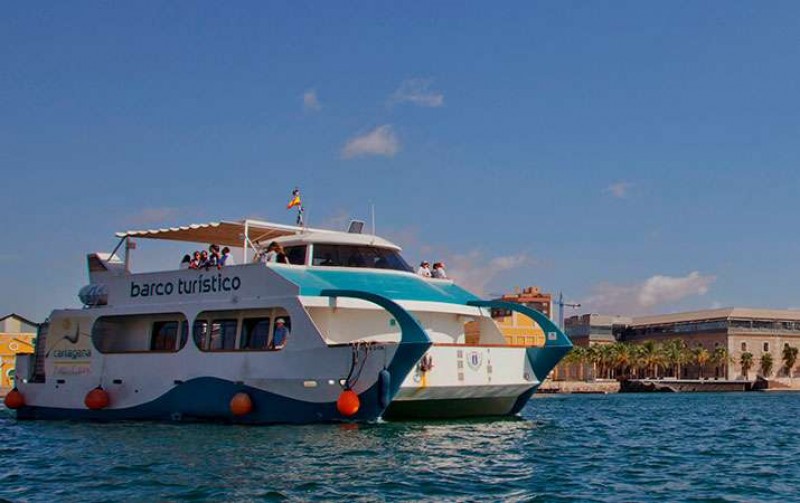
By boat: the tourist boat leaves from the seafront in the centre of Cartagena, click here for information regarding timetables.
By car:
This can be as much fun as you want to make it!
The Fuerte de Navidad is on the headland which forms the western side of the sea entrance to the bay of Cartagena, and access is along the Carretera de Algameca, which first follows the western bank of the large “rambla de Banipilá”, the floodwater channel which cuts through the city. Heading south along this road, after under a kilometre cross a bridge over the rambla where the fort is signposted along with the Navantia shipyard, and immediately turn right.
The road now takes you along the skirt of the mountain around the back of the shipyard, affording views of the navy ships and yachts of the super-rich which are in for repair, until it ends at the “El Chalé” marina and cafeteria and the Fuerte de Navidad.
For a more adventurous detour on the way, taking in a fishing village which seems to belong to a previous century, click here!
Practicalities of visiting the Fuerte de Navidad
Access to the fort is via a long, winding ramp which makes it hard work for someone in a wheelchair or with limited mobility, although once inside there are visuals on the ground level and a lift to the top floor with its panoramic views.
The nature of this fort means there are also uneven surfaces.
The following services for those with disabilities and impairments are on offer:
Adapted toilets.
Audio-visuals (with sub-titles in English) and oral commentary in Spanish for people with visual and hearing disabilities.
Audio guides with in both Spanish and English for people with visual disabilities.
Reduced admission fees for the disabled (see above).
Guide dogs are admitted with the corresponding accreditation.
For full information in English about the Cartagena municipality CLICK HERE
For full information about places to visit in Cartagena city CLICK HERE
Cartagena
El Carmoli
Islas Menores and Mar de Cristal
La Manga Club
La Manga del Mar Menor
La Puebla
La Torre Golf Resort
La Union
Los Alcazares
Los Belones
Los Nietos
Los Urrutias
Mar Menor Golf Resort
Pilar de la Horadada
Playa Honda / Playa Paraiso
Portman
Roldan and Lo Ferro
San Javier
San Pedro del Pinatar
Santa Rosalia Lake and Life resort
Terrazas de la Torre Golf Resort
Torre Pacheco
Aledo
Alhama de Murcia
Bolnuevo
Camposol
Condado de Alhama
Fuente Alamo
Hacienda del Alamo Golf Resort
Lorca
Mazarron
Puerto de Mazarron
Puerto Lumbreras
Sierra Espuna
Totana
Abaran
Alcantarilla
Archena
Blanca
Corvera
El Valle Golf Resort
Hacienda Riquelme Golf Resort
Lorqui
Molina de Segura
Mosa Trajectum
Murcia City
Peraleja Golf Resort
Ricote
Sucina
Condado de Alhama
El Valle Golf Resort
Hacienda del Alamo Golf Resort
Hacienda Riquelme Golf Resort
Islas Menores and Mar de Cristal
La Manga Club
La Torre Golf Resort
Mar Menor Golf Resort
Mazarron Country Club
Mosa Trajectum
Peraleja Golf Resort
Santa Rosalia Lake and Life resort
Terrazas de la Torre Golf Resort
La Zenia
Lomas de Cabo Roig

CAMPOSOL TODAY Whats OnCartagena SpainCoronavirusCorvera Airport MurciaMurcia Gota Fria 2019Murcia property news generic threadWeekly Bulletin





































